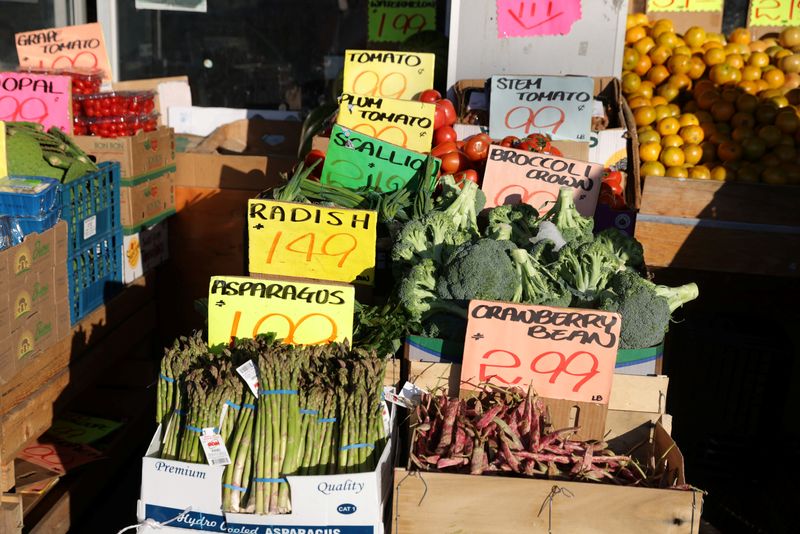
© Reuters. Prices of fruit and vegetables are on display in a store in Brooklyn, New York City, U.S., March 29, 2022. REUTERS/Andrew Kelly
(Reuters) -Trade tensions between Washington and Beijing are riding high while U.S. inflation data will inform the Federal Reserve’s next move and rate setters in New Zealand and Canada meet.
Here’s a look at the week ahead in markets from Lewis Krauskopf and Nupur Anand in New York, Li Gu in Shanghai, Kevin Buckland in Tokyo, and Naomi Rovnick and Amanda Cooper in London.
1/ UNDER PRESSURE
Markets have come around fast to the Fed’s view that instead of being cut anytime soon, rates will remain high for longer. After another brutal bond sell off, focus turns to Wednesday’s U.S. inflation data. Price pressures have been easing but perhaps not fast enough with a July rate hike seen as likely.
May CPI data showed the smallest year-on-year increase since March 2021 – but at 4%, that was still well above the Fed’s 2% target. Just like the latest personal consumption expenditures index showed similarly slowing inflation also above the Fed ‘s comfort zone.
June meeting minutes showed a united Fed agreed to hold rates steady, buy time and assess whether further hikes would be needed. The answer seems yes. And the most deeply inverted bond yield curve since the 1980s suggests investors bracing for another hike also expect Fed tightening raises recession risks.
2/ FIGHTING FIRES
China is fighting a hi-tech trade war with Washington while grappling with a sputtering economy.
After months of tightening of restrictions by the U.S. and key allies on chip-related imports, Beijing hit back in recent days with curbs on chip-making metal exports, and a warning of more to come.
Treasury Secretary Janet Yellen’s visit to Beijing over the weekend seems to have calmed the waters somewhat – while there was no breakthrough, both sides described their talks as “productive” and agreed to keep channels open “at all levels” for discussions on the economy.
Things aren’t looking bright on the economic front though.
Data out on Monday showed China’s factory-gate prices fell at the fastest pace in seven-and-a-half years in June, while consumer inflation was at its slowest since 2021. Thursday’s trade numbers are expected to see a continued decline in exports – all pointing to lacklustre demand.
Hopes for major Politburo policy support at month-end seem to have faded. Goldman Sachs (NYSE:) said that conversations with their local clients showed they now expected to see measures aimed only at easing economic headwinds, rather than generating strong growth.
3/ PAUSE AND EFFECT
Skips, pauses and pivots dominate monetary policy conversations as persistent inflation has seemingly consigned central-bank forward guidance to the dustbin of history. Increasingly, policymakers say decisions depend on future data, making it harder for traders to formulate a view on the outlook.
The Reserve Bank of New Zealand (RBNZ) – one of the first major central banks to start tightening policy – has raised rates by 525 basis points since October 2021 – the most among the G10. In May, it signalled it had finished raising rates, but at its meeting on Wednesday longer-term clarity may remain out of reach with inflation running at 6.7% and the economy in recession.
The Bank of Canada, meeting the same day, is in the data-dependent corner, leaving markets split down the middle on whether it will raise or pause.
4/BANK EARNINGS
U.S. banking giants sailed through the Fed’s annual health check in late June, highlighting they have enough capital to weather a severe economic downturn.
But now it’s time for earnings, with JPMorgan Chase (NYSE:), Citigroup (NYSE:) and Wells Fargo (NYSE:) all scheduled to report second-quarter earnings on July 14.
The picture looks not so rosy with results predicted to be weighed down by sluggish dealmaking and trading revenue while a dearth of investment-banking activity has prompted banks to lay off thousands of employees.
Meanwhile, the largest U.S. lenders are expected to keep tightening credit standards given the uncertain economic environment, particularly after bank failures earlier this year. Analysts focus on banks’ lending outlook and how much they set aside in rainy-day funds to cushion losses from souring loans.
5/ TROUBLE IN CREDIT LAND
Debt-laden companies are running into trouble.
Embattled French retailer Casino (EPA:), with 3 billion euros ($3.3 billion) of debt maturing in the next two years, has until end-July to agree a restructuring plan.
Britain’s Thames Water, with 14 billion pounds of borrowings, said on Monday investors had agreed to invest 750 million pounds ($960 million) – but warned it would need more funding in the years ahead.
Sweden’s commercial landlord SBB is fighting for survival.
In the U.S., junk-rated companies have to refinance almost $1.2 trillion of borrowings by 2026, according to S&P Global Ratings. At the same time, the market for collateralised loan obligations – vehicles formed by specialist asset managers that buy about 60% of all junk-rated loans and package them up into bonds – has almost shuddered to a halt.
Stock market valuations do not reflect any credit-related worries yet – but that may just be the eye of a storm.
>>> Read full article>>>
Copyright for syndicated content belongs to the linked Source : Investing.com – https://www.investing.com/news/economy/take-five-mind-the-curve-3122128






























